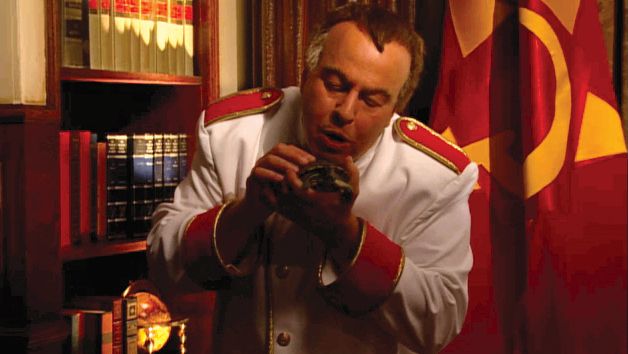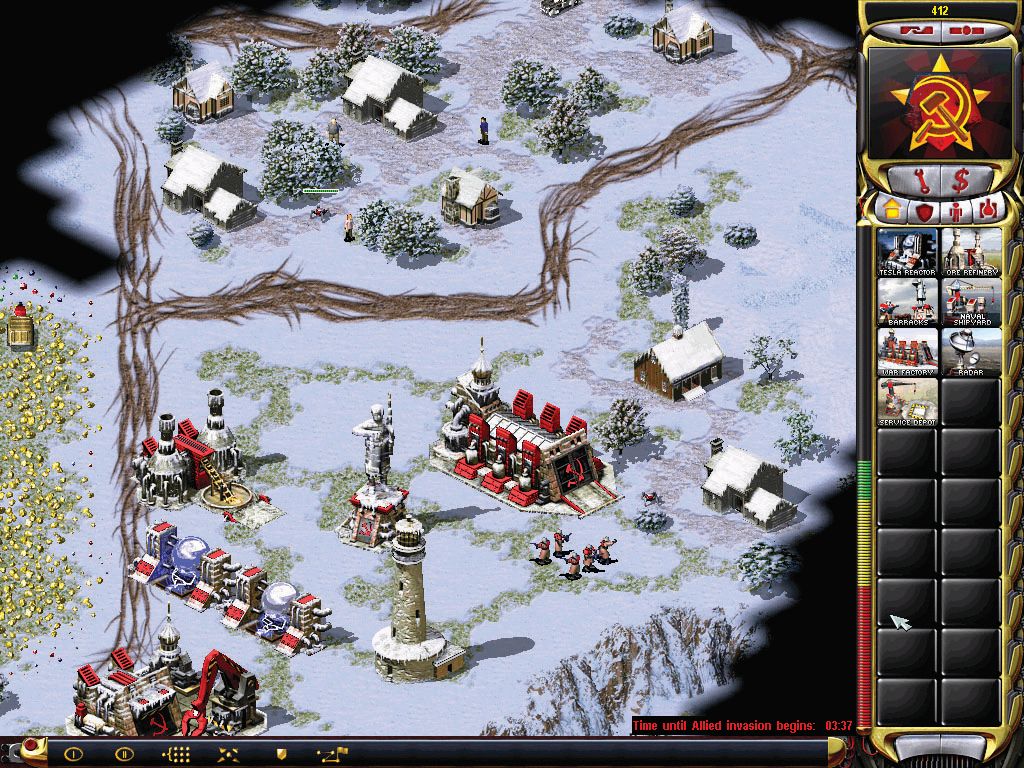Funny, self-aware, and still fun today, Command & Conquer: Red Alert 2 holds up
A hell of a march through the USA.

In 2008, when EA tried to resurrect the Red Alert series with Red Alert 3, its marketing focused on the tongue-in-cheek, deliberately ludicrous story. Trailers showed George Takei, Tim Curry, and JK Simmons chewing the scenery of their respective Empire, Soviet, and Allied war rooms. Official descriptions heralded the return of the "humour" and "popcorn style story". It's fitting that Red Alert, of all series, should be the subject of such revisionist history.

"American OS weak like turtle without shell. To bring glory to Mother Russia, download Aqrit's ddwrapper. Extract ddraw.dll and aqrit.cfg into Red Alert 2 folder, then open aqrit.cfg in text editor and change 'ForceDirectDraw Emulation' from '0' to '1'. Save, and play." [Pokes turtle.]
The original Red Alert isn't a comedy. While it opens on Einstein travelling back in time to assassinate Hitler with a fatal handshake—and let's all take a second to think about that—the majority of its cutscenes are played straight. Its absurdities come from stilted acting, basic sets and questionable CGI. But the alt-history conflict between Allies and Soviets isn't portrayed as a fun, campy romp. Red Alert isn't a spin-off to Command & Conquer, but a prequel. The end of its Soviet campaign depicts the rise of Kane and the Brotherhood of Nod. In this light, it's not surprising that its tone would match the more consistently serious main series.
It was Red Alert 2, released in 2000—a couple of years after C&C sequel Tiberian Sun—that changed the mood and overarching story, ditching all ties to the Tiberian series in favour of a second war between the Soviets and Allies. Little attempt is made to dramatise events. In the first briefing of the Soviet campaign, Premier Romanov pokes a turtle named Uncle Sam as part of an extended metaphor about America being weak and cowardly. US President Dugan—played by Twin Peaks' Ray Wise—is nervous and petulant throughout. The Soviet invasion itself is triggered when a psychic with a head tattoo mind-controls a soldier through a telephone. It's all very silly.
Played today, this tonal shift stops Red Alert 2 from feeling overly dated. The obvious comparison is to Tiberian Sun, which even James Earl Jones can't save from an awkward mix of drama, action and scantily clad mutant sidekicks. I don't remember Tiberian Sun being quite so embarrassing at the time, probably because I was 14. Now it's hard not to cringe through the cutscenes. Red Alert 2 avoids that fate because you can tell its cast are having fun. It's a knowing nod to the camera; an admission that, yes, it's a new millennium and we're still doing FMV. Importantly, though, it's not ironic. It embraces the awkwardness. It owns it.
Despite this, Red Alert 2's reinvention was likely a consequence of internal drama. Many Westwood developers left after EA purchased the studio, likely necessitating a much different sequel than was ever planned. Certainly the loose story threads of Red Alert 1 are left dangling. Is it stupid to expect continuity from a series featuring time travel? Maybe, but Red Alert 2 doesn’t even try. It would have been easy enough to write in some brief, ridiculous-sounding time shenanigans to explain the new timeline. Instead, we go straight to the buffoonery and mind control.
EA's acquisition and eventual destruction of Westwood is still a sore point among fans, and for good reason. But Red Alert 2 finds itself in the sweet spot of the studio's troubled history. Those staff who left likely wouldn't agree, but the proof is in the product. This is one of Westwood's finest—a brilliant balance of fast action, inventive design and streamlined strategy. Its campaigns are memorable, and buoyed by the focus on familiar US landmarks. Red Alert 2 also improves and polishes C&C's major systems far more than any of its predecessors. For all of Tiberian Sun's visual and engine improvements, many of its planned features were scrapped—another consequence of EA's purchase, and the pressure for an earlier than planned release.

Not that any of Red Alert 2's new features make a huge difference to the strategy. Garrisoning troops is a nice addition, but of limited use in a series that's more about production than micromanagement. And while capturing neutral tech buildings can grant useful bonuses, none of their rewards are so major that it's worth expending serious effort or resources to secure them.
Keep up to date with the most important stories and the best deals, as picked by the PC Gamer team.
It's the more subtle tweaks and additions that make Red Alert 2 superior to Tiberian Sun. By organising the production sidebar into tabs, it becomes easier to find specific units and buildings—thus easier to react to the current situation. In fact, skirmishes as a whole feel more streamlined. Tiberian Sun doesn't have more units in total, but the greater focus on ground combat leads to an unnecessary level of obfuscation. Its units are all different, but rarely so different that they'd each form the cornerstone of a distinctive strategy. Red Alert 2 has naval construction, and so spreads out its units over land, sea and air. As such, the battlefield feels cleaner, but also more varied.
As in any RTS, both sides have different units and buildings. But RA2 feels like it embraces each faction's differences more completely than previous Command & Conquer games. Even the respective resource harvesters are different. The Soviet one has a mounted machine gun, finally giving the vehicle a defensive measure more effective than trying to squash soldiers under the wheels. The Allied one can teleport back to its refinery, shortening the amount of time it spends on the move. Both are interesting tweaks to an otherwise boring unit, and feel in keeping with the personality of each side.

Somewhere in the mix of units—the unhinged Soviet explosive experts, the lightning troopers, the dolphins and squids, the teleporting legionnaires who delete things from time—Red Alert 2 feels more like a cartoon than its predecessor. The tonal shift works for the mission briefings, but, looking at it now, not so much on the battlefield. The first game felt bleak, conveying a sense of realism that hammered home the power and devastation of its weapons. The Tesla Coil was cool precisely because it felt so ominous and terrifying. But Red Alert 2 is a fun romp, and so the destruction wrought by its superweapons feels ultimately less powerful.
That aside, I find myself surprised by how much I still enjoy Red Alert. In recent years I started to suspect that the Command & Conquer series wasn't as good as fans—myself included—made out. I started to misremember it as dumb and lightweight, devoid of any real strategy. That's not the case at all, despite the focus on speed and action. This is still a legitimately good RTS, filled with interesting and enjoyable decisions. Yes, it also lets you build a shitload of tanks, but that just speaks to the diversity of approach it offers.
I shouldn't be so surprised. After all, Red Alert 2's lead designer was Dustin Browder, who would go on to lead StarCraft 2's development team. This remains a fine product from a fantastic era of RTS design.

Phil has been writing for PC Gamer for nearly a decade, starting out as a freelance writer covering everything from free games to MMOs. He eventually joined full-time as a news writer, before moving to the magazine to review immersive sims, RPGs and Hitman games. Now he leads PC Gamer's UK team, but still sometimes finds the time to write about his ongoing obsessions with Destiny 2, GTA Online and Apex Legends. When he's not levelling up battle passes, he's checking out the latest tactics game or dipping back into Guild Wars 2. He's largely responsible for the whole Tub Geralt thing, but still isn't sorry.

